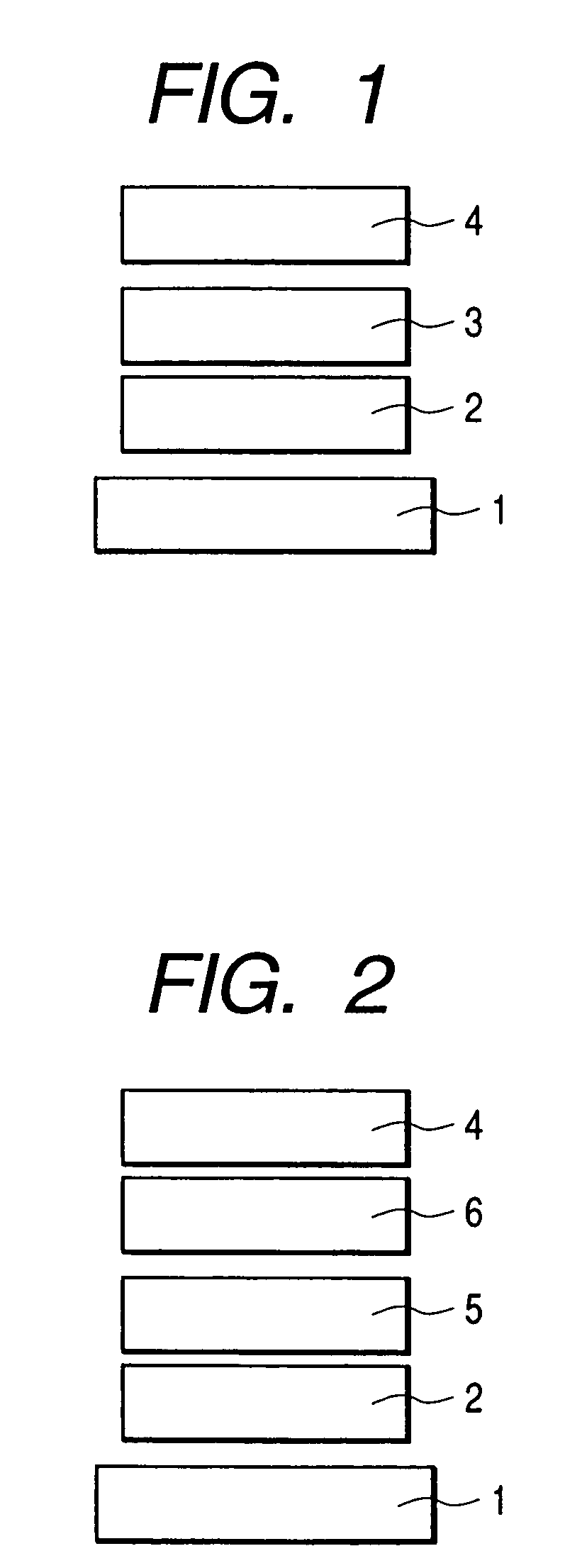Fluorene compound and organic luminescent device using the same
- Summary
- Abstract
- Description
- Claims
- Application Information
AI Technical Summary
Benefits of technology
Problems solved by technology
Method used
Image
Examples
synthesis example 1
Synthesis of Exemplified Compound No. 1
[0084]
[0085]To a 500-ml three-neck flask, 2.0 g (5.68 mmol) of 2,7-dibromo-9,9-dimethylfluorene [1], 4.2 g (17.0 mmol) of pyrene-1-boronic acid [2], 120 ml of toluene, and 60 ml of ethanol were added. Then, an aqueous solution of 24 g of sodium carbonate / 120 ml of water was dropped thereinto with stirring in a nitrogen atmosphere at a room temperature, followed by the addition of 0.33 g (0.28 mmol) of tetrakis (triphenylphosphine) palladium (0). After stirring the mixture for 30 minutes at a room temperature, the temperature was allowed to rise to 77° C., followed by stirring for 5 hours. After the reaction, an organic layer was extracted with chloroform and was then dried with anhydrous sodium sulfate, followed by purification with a silica gel column (hexane+toluene mixture developing solvent). Consequently, 3.0 g (89% yield) of an exemplified compound No. 1 (white crystal) was obtained.
synthesis example 2
Synthesis of Exemplified Compound No. 6
[0086]
[0087]To a 500-ml three-neck flask, 3.0 g (5.49 mmol) of dibromofluorene compound [3], 4.0 g (16.5 mmol) of pyrene-1-boronic acid [2], 100 ml of toluene, and 50 ml of ethanol were added. Then, an aqueous solution of 20 g of sodium carbonate / 100 ml of water was dropped thereinto with stirring in a nitrogen atmosphere at a room temperature, followed by the addition of 0.33 g (0.28 mmol) of tetrakis (triphenylphosphine) palladium (0). After stirring the mixture for 30 minutes at a room temperature, the temperature was allowed to rise to 77° C., followed by stirring for 5 hours. After the reaction, an organic layer was extracted with chloroform and was then dried with anhydrous sodium sulfate, followed by purification with a silica gel column (hexane+toluene mixture developing solvent). Consequently, 3.4 g (79% yield) of an exemplified compound No. 6 (white crystal) was obtained.
synthesis example 3
Synthesis of Exemplified Compound No. 7
[0088]
[0089]To a 500-ml three-neck flask, 3.0 g (4.07 mmol) of dibromofluorene compound [4], 3.0 g (12.2 mmol) of pyrene-1-boronic acid [2], 100 ml of toluene, and 50 ml of ethanol were added. Then, an aqueous solution of 16 g of sodium carbonate / 80 ml of water was dropped thereinto with stirring in a nitrogen atmosphere at a room temperature, followed by the addition of 0.23 g (0.20 mmol) of tetrakis (triphenylphosphine) palladium (0). After stirring the mixture for 30 minutes at a room temperature, the temperature was allowed to rise to 77° C., followed by stirring for 5 hours. After the reaction, an organic layer was extracted with chloroform and was then dried with anhydrous sodium sulfate, followed by purification with a silica gel column (hexane+toluene mixture developing solvent). Consequently, 2.7 g (68% yield) of an exemplified compound No. 7 (white crystal) was obtained.
PUM
| Property | Measurement | Unit |
|---|---|---|
| Time | aaaaa | aaaaa |
| Time | aaaaa | aaaaa |
| Time | aaaaa | aaaaa |
Abstract
Description
Claims
Application Information
 Login to View More
Login to View More - Generate Ideas
- Intellectual Property
- Life Sciences
- Materials
- Tech Scout
- Unparalleled Data Quality
- Higher Quality Content
- 60% Fewer Hallucinations
Browse by: Latest US Patents, China's latest patents, Technical Efficacy Thesaurus, Application Domain, Technology Topic, Popular Technical Reports.
© 2025 PatSnap. All rights reserved.Legal|Privacy policy|Modern Slavery Act Transparency Statement|Sitemap|About US| Contact US: help@patsnap.com



